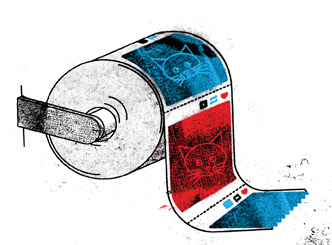Tumbling Into Context: Against "Against Tumblr"

Illustration by Yarek Waszul.
Two years ago, the US National Archives started using Tumblr to publish photos and other historical documents that are now being transferred to digital formats. The project is organized in a way that ties in with daily events. On “Bike to Work Day,” for example, the Archives published an old photograph of two people on a tandem bicycle. The reblogging feature on Tumblr (called tumblelogging) resulted in this photograph being reposted on thousands of other pages, from bicycle-themed blogs to blogs of old photos to personal blogs.
Projects like this use Tumblr in a way that John Semley, in his article “Against Tumblr,” published in Maisonneuve’s Winter 2012 issue, largely ignores. In his piece, Semley acknowledges the value of some Tumblr blogs, but considers these the exception rather than the rule. Most Tumblr accounts, he argues, are personal blogs, primarily composed of a stream of images whose individual meaning is erased. But, while Semley argues that Tumblr is simply “content without context,” the nature of tumblelogging is quite the opposite.
It is important to consider the complexity of what happens in the process of tumblelogging. Tumblr does not erase context, as Semley argues. Rather, a new context is created for the reblogged image whenever it is placed within a new blog. A blog already has contexts determined by its existing content, and its content informs the meaning of a newly tumblelogged image—most obviously through the already-present images placed in its surroundings, as well as through other components such as the layout or title. The contextualization and recontextualization of objects on Tumblr activates new meanings, where the same image can take on different emphases dependent upon its surrounding images.
A good example of this comes from the “Fuck Yeah” series of blogs. There are thousands of these blogs, which celebrate a chosen theme, ranging from drugs, cities, the colour yellow, sex, celebrities and so on—and each of these blogs establishes a specific theme that decides their content. The same photo of Ewan MacGregor, for example, could show up on different blogs for different purposes, depending upon the blog itself. In many cases, the contexts created by the content of a blog reveal broad forms of cultural desire. Tumblelogging, then, is a form of cultural curation. It expresses desires plainly, or uses their expression as an element of subjective representation. It is a lot like posting images of desire on one's bedroom walls in ways that establish one's identity and interests. Tumblelogged images of Ryan Gosling, LeBron James or fashion models are not all that different from the posters of Roberto Alomar and Joe Strummer that I had tacked up in my childhood bedroom.
The difference is that Tumblr offers a social network in which the expression of one’s desire can be shared. The internet, and Tumblr as a part of it, represents desires in the context of a person’s lifestyle—interior-design photos can be found placed alongside celebrity worship or inspirational quotes. This kind of composite structuration is one of the more interesting aspects of social networks, including Twitter and Instagram. Your account can be filled with your friends, but can also be composed of celebrities, dogs, parody accounts and news articles.
In almost all of the cases that Semley rejects, the practice of tumblelogging is one of desire and its expression. If we disallow ourselves from talking about desire, we leave little else to discuss. And Tumblr is only one element among many that inform one's sense and representation of subjectivity. Thinking of Tumblr as a vehicle for the composite formations of identity, for the representation of desire, is to recognize its legitimacy.
If there is an important criticism to be made of tumblelogging, it is not that it produces content without context. Rather, it is that the content of tumblelogging is inextricably tied to cultural capital, which runs parallel to functions of desire. (Later in his piece, Semley hints at this critique.) But this is a general criticism to be made of cultural practices, of which Tumblr is only a part. Of course, even this criticism is unable to address tumblelogging as a whole. Yes, it might seem absurd to spend time thinking about a cat playing a keyboard. But there isn’t much point in arguing, as Semley does, that such memes are “spoiling the internet,” as if the web has a limited space for usability.
Semley opens his article by recalling a rock tumbler in his childhood classroom. He describes how using the tumbler recontextualizes the rocks placed in it. However the result is qualified—Semley describes it as “uninteresting”—it is “the same” rock, but, recontextualized by the tumbler, it attains new characteristics brought about within new circumstances. If we keep with Semley's metaphor, then we see that the images on Tumblr that are blogged and reblogged never do lose context or become uninteresting. By appearing and reappearing over again, they always exist within a context.





